Fritillaria stribrnyi
The first Flora of Bulgaria was published by the Czech Josef Velenovský in 1891. In the course of his work on the Bulgarian flora he made six visits to Bulgaria between 1884 and 1887 and it was on his third visit in 1889 he meet Václav Střibrný, a fellow Czech working in Bulgaria. Střibrný became an assiduous collector for Velenovský and it was on one of Střibrný collecting trips that he discovered this new Fritillaria growing below thorn-bushes, near Nova Mahala, in 1892. The following year, on his forth collecting trip to Bulgaria, Velenovský collected further specimens in fruit and later that year described Střibrný new species as Fritillaria stribrnyi. Morphologically it is close to F. bithynica; both have narrow-campanulate flowers with a slender glabrous style and winged capsules. However, F. stribrnyi is taller and with more leaves and varying degrees of purple colouring to the flowers. In 1970 Professor Baytop discovered F. stribrnyi in European Turkey so extending its range closer to the northern limit of F. bithynica. Most Fritillaria have an unpleasant scent but F. stribrnyi has a sweet fragrance like a viola and is probably pollinated by small bees.
Fritillaria stribrnyi Velen. in Sitzungsber. Königl. Böhm. Ges. Wiss., Math.-Naturwiss. Cl. 37: 61 (1893).
Description: Bulb to 2 cm diam., sometimes with a few bulblets which form on the upper half of the outside of the scales. Stem 10-30(-80) cm. Leaves (7-)10-14, green, not glaucous; lowest oblong-lanceolate to linear, 4-10 x 0.5-2 cm, obtuse, alternate. Flowers 1-3; perianth narrowly campanulate, outside purple or glaucous green edged purple; inside yellowish edged purple, not tessellated. Outer segments oblong-lanceolate, acute, 20-28 x 4-6 mm, inner obovate-cuneate or obtuse, 7-10 mm broad. Nectaries 2 x 1 mm, at base of perianth. Filaments 7-9 mm, slender, densely papillose. Style 7-12 mm, very slender, straight sided, smooth. Capsule broadly 6-winged, wings irregularly toothed.
Flowers: Flower: April-May.
Habitat: Woods, scrub & grassy places
Elevation: 0-1000 m.
Chromosome number 2n = 24 (Başak 1991).
Type: [Bulgaria] in dumosis regionis inferioris calidae ad Nova Mahala (distr. Philippop.), 1892, Střibrný (holo. PRC), type? BM
Distribution: SE Bulgaria & European Turkey (Trace)
Cultivation: Not difficult in a bulb frame or raised bed, kept moist throughout the year.
Conservation Status: Bulgaria - Critically Endangered (CR)
References
Başak, N. 1991. The genus Fritillaria (Liliaceae) in European Turkey. Botanika Chonika 10: 841-844.
Hayek, A. 1933. Prodromus Florae Peninsulae Balcanicae p.67.
Petrova, A. & Vladimirov, V. (eds). 2009. Red List of Bulgarian vascular plants. Phytol. Balcan, 15(1): 63-94.
Rix, M. 1979. Notes on Fritillaria (Liliaceae) in the Eastern Mediterranean region: IV. Kew Bulletin 33:587-589, fig. 1. (Available from www.jstore.org)
Turrill WB, Sealy JR. 1980. Hooker’s Icones Plantarum 39(1-2): 173-174, t.3835.
Velenovský, J. 1893. Sitzungsber. Königl. Böhm. Ges. Wiss., Math.-Naturwiss. 37: 61.
Velenovský, J. 1898. Flora Bulgarica, Supplementum I: 270.
Laurence Hill ©2010
![]()




